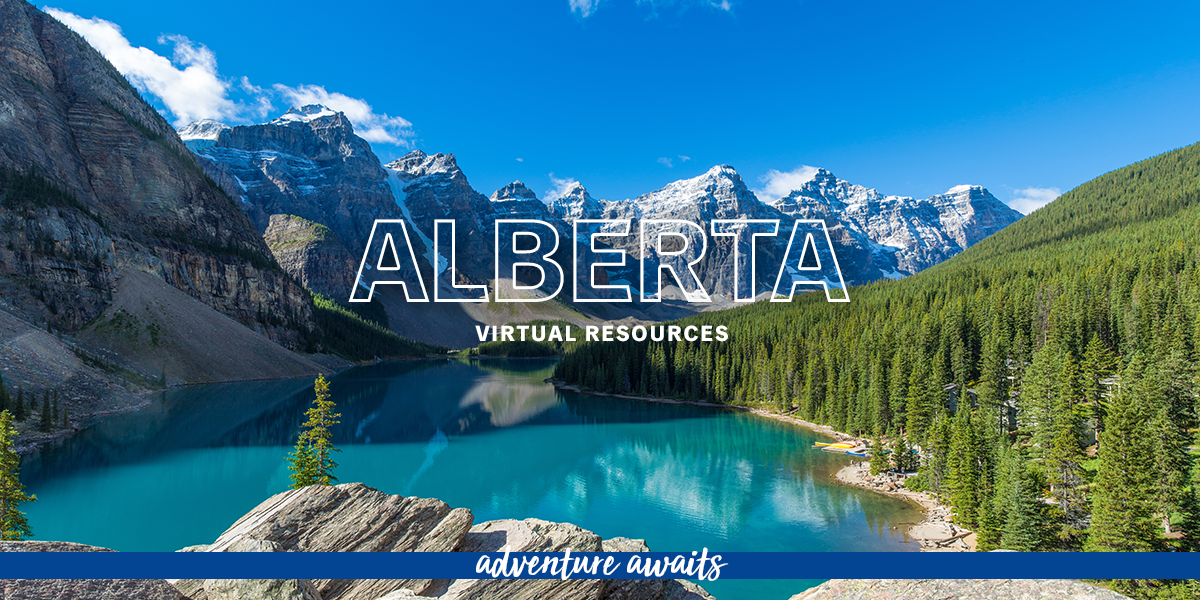Learn the province
The flag of Alberta is represented by a blue background with the provincial shield placed in the middle. The shield has many layers, the top of which is a red cross representing King George III to illustrate British heritage. The other layers are representative of the province’s diverse and widely recognizable landscape: blue skies, the Rocky Mountains, green valleys, prairies, and golden wheat fields.
Alberta’s coat of arms uses the same provincial shield as the flag, with several additional symbols. Sitting atop the crest is a beaver wearing a crown and red and white wreath. The beaver is the official animal of Canada, and red and white represent the Canadian flag. On either side of the beaver is a lion, representing power, and an antelope, representing the province’s natural resources. The crest sits atop a bed of wild roses, Alberta’s official flower, with the words ‘Fortis et Liber’ written across the bottom, meaning strong and free.
Study some history
Alberta was formed in 1905 as the seventh province of Canada, and shortly afterward Edmonton was named its capital. The name Alberta was adopted from Queen Victoria’s fourth daughter, Princess Louise Caroline Alberta, who is also the namesake for Banff’s iconic Lake Louise.
There have been three major waves that were vital to the settlement and growth of Alberta’s population and development as an important economic hub. The first large wave of settlers can be traced back to the cattle ranchers who travelled north from the United States to set up their operations. The next major wave, and probably more noteworthy, was the construction of the countries railroad system, as well as the government’s homesteader grants (of which around 40,000 were handed out).
The most significant wave and source of socio-economic change in Alberta’s history, however, stems from the discovery of oil in 1947 near Edmonton. This discovery nearly turned Alberta from an agriculture-based society to one of the most economically wealthy areas in North America—overnight!
Get creative
Organize your art supplies and get painting! Pick a particular location you’ll visit on your trip and compare your artwork to photos of the location when you return. Consider painting the scenic town of Banff, nestled in the Rocky Mountains; the famous Lake Louise; or the iconic water park in West Edmonton Mall, the largest shopping mall in North America.
Pick a film
Watch a movie or TV show that was filmed in (or relates to) your destination. Some ideas for Alberta include:
- Cool Runnings (1993)
- Superman (1978)
- Fargo (2014)
Understand the culture
Known for its country roots, it’s no surprise Alberta is famous for its country music scene, as well. Many of Canada’s famous country artists and songs are strongly rooted in the province of Alberta. Alongside country music comes the famous cowboy culture. Rodeos are a popular tradition in Alberta—in fact, an event called the Calgary Stampede draws over a million attendees from across the country each July. There is no event quite like it, as people come to soak in true Alberta culture by watching the bucking bulls, listening to some good ‘ol country music, and filling up on loads of barbequed Alberta beef!
If you want to understand the culture of Alberta better, this is one simple way to put it. Once someone is pronounced an honorary figure in Calgary, rather than receiving a key to the city as most others do, they are gifted a white cowboy hat while reciting the following oath:
“I, [recipient’s name], havin’ visited the only genuine Western city in Canada, namely Calgary, and havin’ been duly treated to exceptional amounts of heart-warmin’, hand-shakin’, tongue-loosenin’, back-slappin’, neighbour-lovin’ Western spirit, do solemnly promise to spread this here brand of hospitality to all folks and critters who cross my trail hereafter. On the count of three, we will all raise our hats and give a loud ‘Yahoo!'”
Enough said.
Examine the economy
Alberta’s top industry is, without doubt, the oil industry. Priding themselves as the energy capital of Canada, in 2016, Alberta alone produced around 80 percent of Canada’s crude oil. Due to Alberta’s oil reservoirs, Canada is ranked the fourth largest producer and exporter of oil in the world. Alberta’s oil sands, the most famous reserve of them all, is the third largest in the world. The oil industry has brought much economic wealth to the region; however, there is great controversy as to its environmental impacts as well as it’s infringement on Indigenous people and their lands.
Don’t forget the meat: due to its vast flat landscape and many cattle farms, Alberta exports huge quantities of beef. This beef is world renowned for its grade A quality and is shipped to 56 different countries around the globe!
Master the language
Due to the large farming and oil industries that are deeply rooted in Alberta’s history and identity, Albertans have adapted a vowel delivery that creates a defining local dialect and slang unique to the province. This dialect is most predominately associated with Southern Alberta, which is home to the world-famous Calgary Stampede, rodeos, ranches, and cowboys. This prairie speech is easily recognizable and may sound strange to Canadians travelling through from other provinces. After all, if you ask an Albertan where they’re from, they’ll reply “‘Berta.”
Aside from the “twang” associated with Albertans, they’re also masters of the slang. For example, Cow-Town is another way of describing one of Alberta’s largest urban hubs, Calgary, due to the many farms surrounding the city.
Did you know?
The town of Drumheller in Alberta is the dinosaur capital of the world due to the high concentration of fossils found there!

